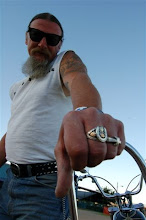Part-timer Steve and I did a good day's work on this frame today. This is the frame half that I had rough cut, sitting behind Justin's frame in the post below.
 On a job like this, it isn't the welding that takes the time. Like painting a bike, it's all the preliminary and prep work that eats up your hours. All the tubing ends need the final trim to length, all the cuts need to be squared, stripped of their coatings, slightly beveled and drilled for plug welding.
On a job like this, it isn't the welding that takes the time. Like painting a bike, it's all the preliminary and prep work that eats up your hours. All the tubing ends need the final trim to length, all the cuts need to be squared, stripped of their coatings, slightly beveled and drilled for plug welding.Then, all the slugs, inserts, and tubes need to be deburred and cleaned inside and out of any rust scale or mill coatings. Next is the cleaning of every part with denatured alcohol or the like in every welding area. Now you can go ahead and assemble everything down with the fixtures, and level everything out front to back, and side-to-side. Next, measurements need to be taken front to back for length on the frame itself, and the axle plates need to be set at the same height, and the width between the axle plates set. If something doesn't square up, now's when you fix it. I try and keep all these measurements to within a 1/16" from side to side, and top to bottom.
With a hardtail job like this one, you need to split the forging on each side of the seatpost, because the angle of the old frame tubing of the top rails doesn't match the angle of the new tubing coming out of the axle plates. The old tubing is higher to allow enough room on the 4 speed frame for the electric start motor, and the oil tank. So, you need to heat the old tubing sections, and bend them down to meet the angle of the new top sections. Once that's done, you can trim the top rails to length, clean, plug drill, etc., etc.
If everything lines up, you can finally start your welding process. First, the plug welds are all done, skipping around from side to side, and top to bottom. Next, all the seam welds are done in the same manner, and I'm constantly checking my measurements as I go. With a frame mod like this, it's almost impossible to get all the welds completed as it sits, so you have to let it cool in the jig, and then pop it out, and finish up any seam areas you have left.
While a hardtail job like this is more involved in some areas than say, putting on a pre-made rigid section, all the prep work, squaring, leveling, and measuring are still the same for both. That's why I kinda smile when I see somebody on the message boards saying "Fuck, I'm not paying that much for a hardtail install, my buddy says he'll weld it on for a 12 pack!" Well, maybe he can, and maybe he can't........
 These are the mild steel axle plates, vs. the stainless from the post below. Both of the axle plate sets, as are all of John's (Hardcore Choppers) castings, are a thing of beauty. Compare these plates sometimes with the ones that Taiwan Tedd sells. In another couple days, we'll have this job completed.
These are the mild steel axle plates, vs. the stainless from the post below. Both of the axle plate sets, as are all of John's (Hardcore Choppers) castings, are a thing of beauty. Compare these plates sometimes with the ones that Taiwan Tedd sells. In another couple days, we'll have this job completed.


























No comments:
Post a Comment